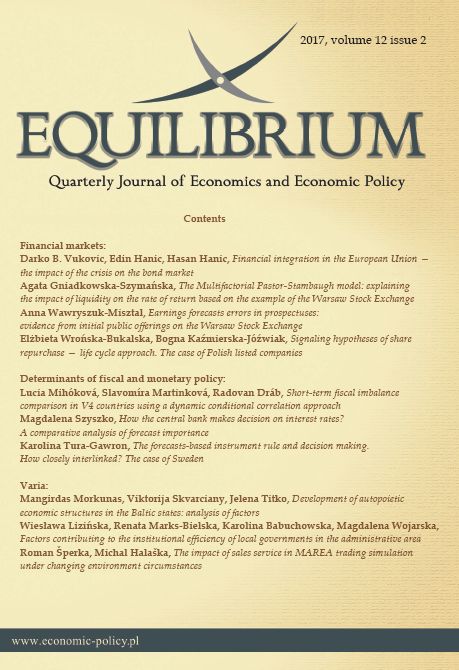THE MULTIFACTORIAL PASTOR-STAMBAUGH MODEL: EXPLAINING THE IMPACT OF LIQUIDITY ON THE RATE OF RETURN BASED ON THE EXAMPLE OF THE WARSAW STOCK EXCHANGE
THE MULTIFACTORIAL PASTOR-STAMBAUGH MODEL: EXPLAINING THE IMPACT OF LIQUIDITY ON THE RATE OF RETURN BASED ON THE EXAMPLE OF THE WARSAW STOCK EXCHANGE
Author(s): Agata Gniadkowska-SzymańskaSubject(s): Economy, Financial Markets
Published by: Instytut Badań Gospodarczych
Keywords: liquidity; the Pastor-Stambaugh model; illiquidity premium
Summary/Abstract: Research background: The liquidity of assets in the financial market is under-stood gener-ally as costs, and the easiest way in which different types of assets can be converted into cash, or to put it simply, sold at the currently available price on the market. For a considerable period of time this category had not been duly considered in the framework of modern finance theory. As a result, a number of basic models constructed within the framework of this theory in its classical form did not include problems with liquidity. This applies to a number of aspects related to liquidity, with one of the most important being the relationship between the liquidity of trading in shares and the results obtained from these rates of return. Purpose of the article: The aim of the article is to determine whether the rate of return on shares increases with the increase in share liquidity and the incremental rate of return on this account decreases with increasing liquidity. The applied re-search methodology is similar to that described by Pastor and Stambaugh (2003). The model used in the empirical study is the expanded model of Fama and Francha (1993) for the liquidity factor. Methods: In this paper I present various factors which will affect the liquidity. The paper will also provide the results of research concerning the relations between spread and stock return on the Warsaw Stock Exchange (WSE). The evidence drawn from WSE stock returns over the period 2004–2012 indicates that Amihuda measure and other variables have a significant effect on stock return using the multifactorial Pastor-Stambaugh. Findings & Value added: In the case of the Polish market, it can be stated that in the analysis based on the Pastor-Stambaugh model not all the variables included in this model are statistically significant. However, directional parameters associated with liquidity risk were statistically significant in all analyzed periods, which allows us to confirm the hypothesis that liquidity has a significant influence on the rate of return on shares listed on the Stock Exchange in Warsaw.
Journal: Equilibrium. Quarterly Journal of Economics and Economic Policy
- Issue Year: 12/2017
- Issue No: 2
- Page Range: 211-228
- Page Count: 18
- Language: English

